How do Plants Cool our Air?

Overview
Overview
Keywords: temperature, energy, water, states of matter, changes of state, evapotranspiration, transpiration, evaporation
Subjects: science, geography
Age group: 6-10 years old
Difficulty level: ● ○ ○ (easy)
![]()
![]()
![]()
This experiment is part of the unit "Flora Focus" written by: Rute Oliveira (PT), Anastasia Papakonstantinou (GR)
Planet Earth is undergoing significant changes in its climate due to human activities. Deforestation is one of the major impacts of human action on climate change.
Evapotranspiration is the process by which water is transferred from the land to the atmosphere. This happens by evaporation from the soil and other surfaces and by transpiration from plants. 1, 2 Understanding evapotranspiration highlights the importance of plants in maintaining environmental balance and the need to protect natural vegetation.
This video tutorial can be easily incorporated into science and geography classes. Teachers can use it as a basis for discussions and activities centred on the impact of human activities such as urbanisation, industrialisation, logging and sustainable solutions.
This project is interdisciplinary, integrating concepts from
- mathematics (presenting results and analysing data),
- communication skills (communicating and writing about environmental issues),
- social studies (understanding the impact of deforestation on different regions and communities),
- and physics (physical states of matter and changes of physical state).
Students will develop critical thinking skills, communication abilities, and environmental consciousness.
The experiment
Required materials
- a plant in a pot
- a pot with soil
- a dry branch or a wooden stick
- 2 plastic bags
- 2 strings
- 2 cotton pads
- 2 elastic bands
- a cup with water
- 2 thermometers
Experiment guide
This activity can be performed by the teacher for the class, but depending on the age and the autonomy level of the students, they can perform it in small groups.
Part I
- Choose a healthy plant in a well-watered pot. It is important that the plant has green, healthy leaves. Use a dry branch (without leaves or vegetation) or a wooden stick in a pot as a control.
- Cover the plant completely with the transparent plastic bag and tie with string. Do the same with the dry branch that will serve as a control.
- Place the plant in a spot with plenty of direct sunlight as this will speed up the evapotranspiration process. Do the same with the control.
- Leave the plant and the dry branch covered with the plastic bag for a few hours, preferably during the hottest part of the day when the sunlight is most intense.
- Observe and note the changes inside the two bags.
Part II
- Take each thermometer and wrap a cotton pad around the bulb (the bottom part) of each thermometer.
- Secure each cotton pad with an elastic band to keep it in place.
- Dip one of the cotton pads in water until it is completely wet, while leaving the other cotton piece dry.
- Take both thermometers outside and place them in a sunny and/or windy area. Ensure they are positioned close together to receive the same amount of sunlight.
- Note the starting temperature of each thermometer.
- Every 10 minutes, check and record the temperature of both thermometers.
- Observe any differences between the wet and dry cotton thermometers.
Notes
The results of this experiment depend on atmospheric conditions. The more sunlight and wind you experience, the faster the results will appear, as water evaporation happens more quickly under these conditions.
Natural phenomena that occur around us are complex and difficult to replicate in the laboratory, therefore we use models. Models are simplifications of reality that allow us to understand what happens in the real world in a more accessible way.
Questions for students
Here are some suggestions for questions that you could ask the students when the video stops.
Easier
- How do plants help to cool the environment?
- Why is it cooler under a tree on a hot day?
More challenging
- How does evapotranspiration contribute to the water cycle in nature?
- What factors lead to deforestation?
The experiment with the result
Evapotranspiration is a process that combines evaporation and transpiration. Evaporation occurs when water in the soil passes from a liquid state to a gaseous state and enters the atmosphere. Transpiration occurs in plants when they release water vapour, through their leaves, into the air. The water that is lost is replaced by water that the plant absorbs from the soil through its roots and distributes throughout the plant. This essential process is part of the water cycle, as it returns water to the atmosphere which leads to the formation of clouds and precipitation.
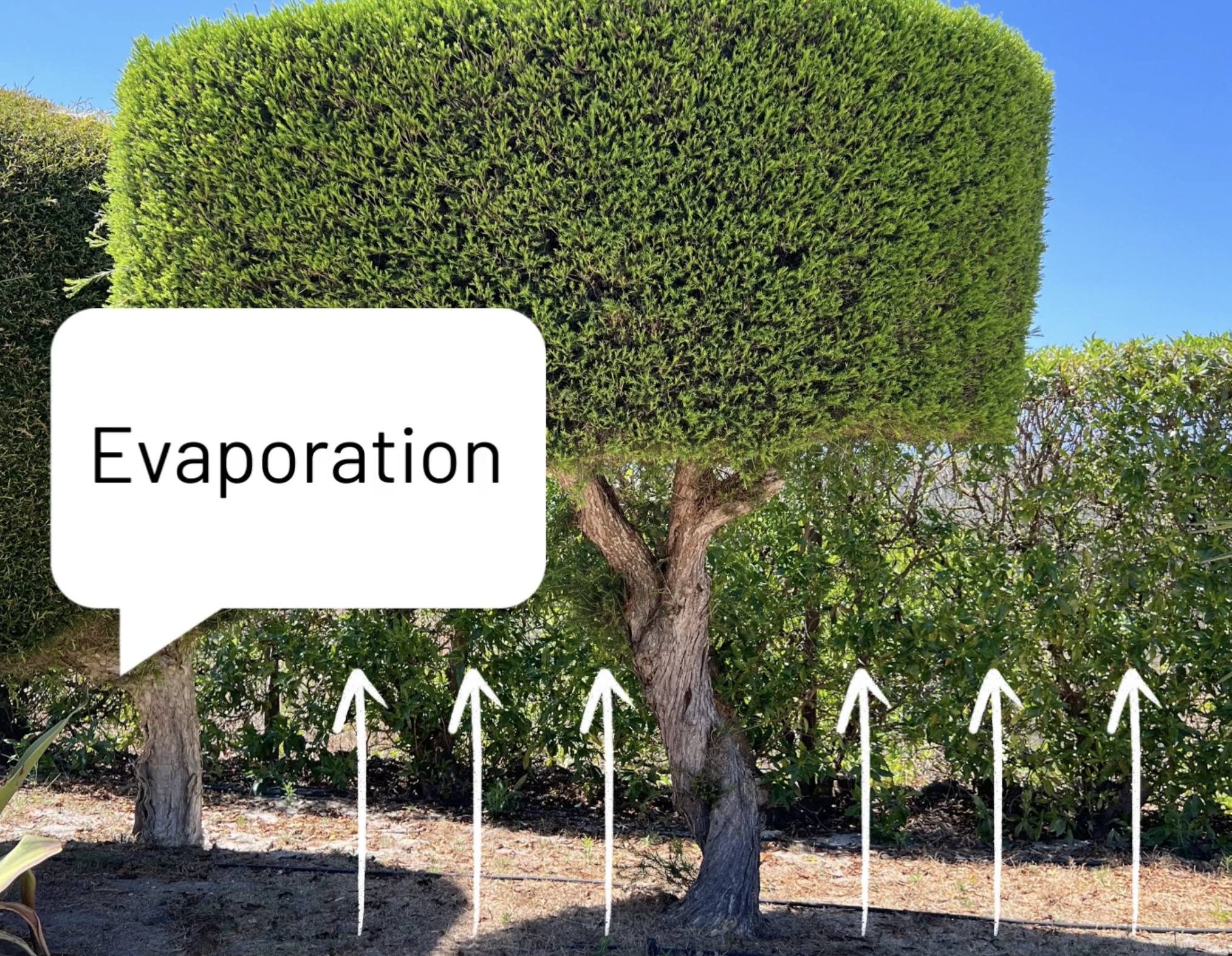
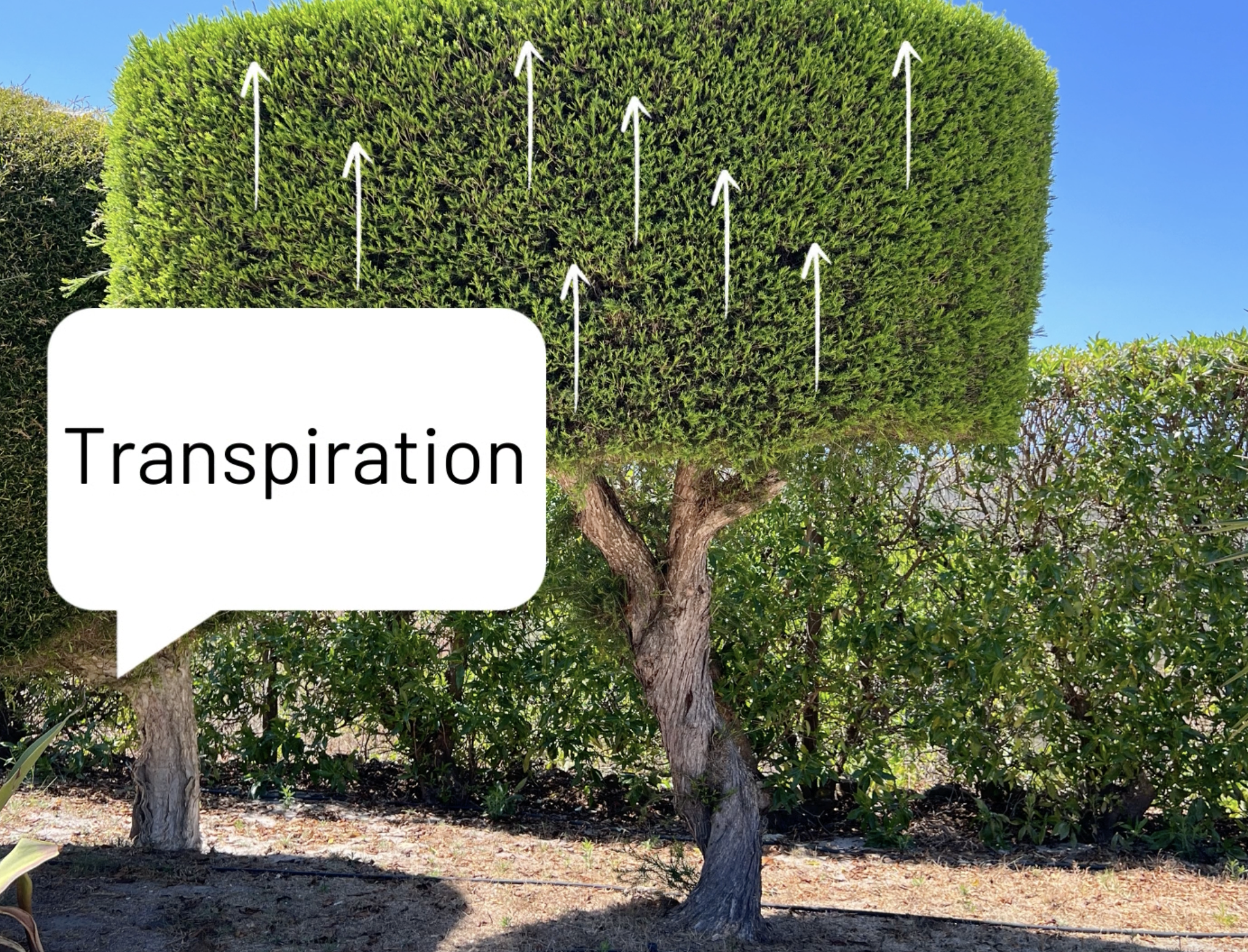
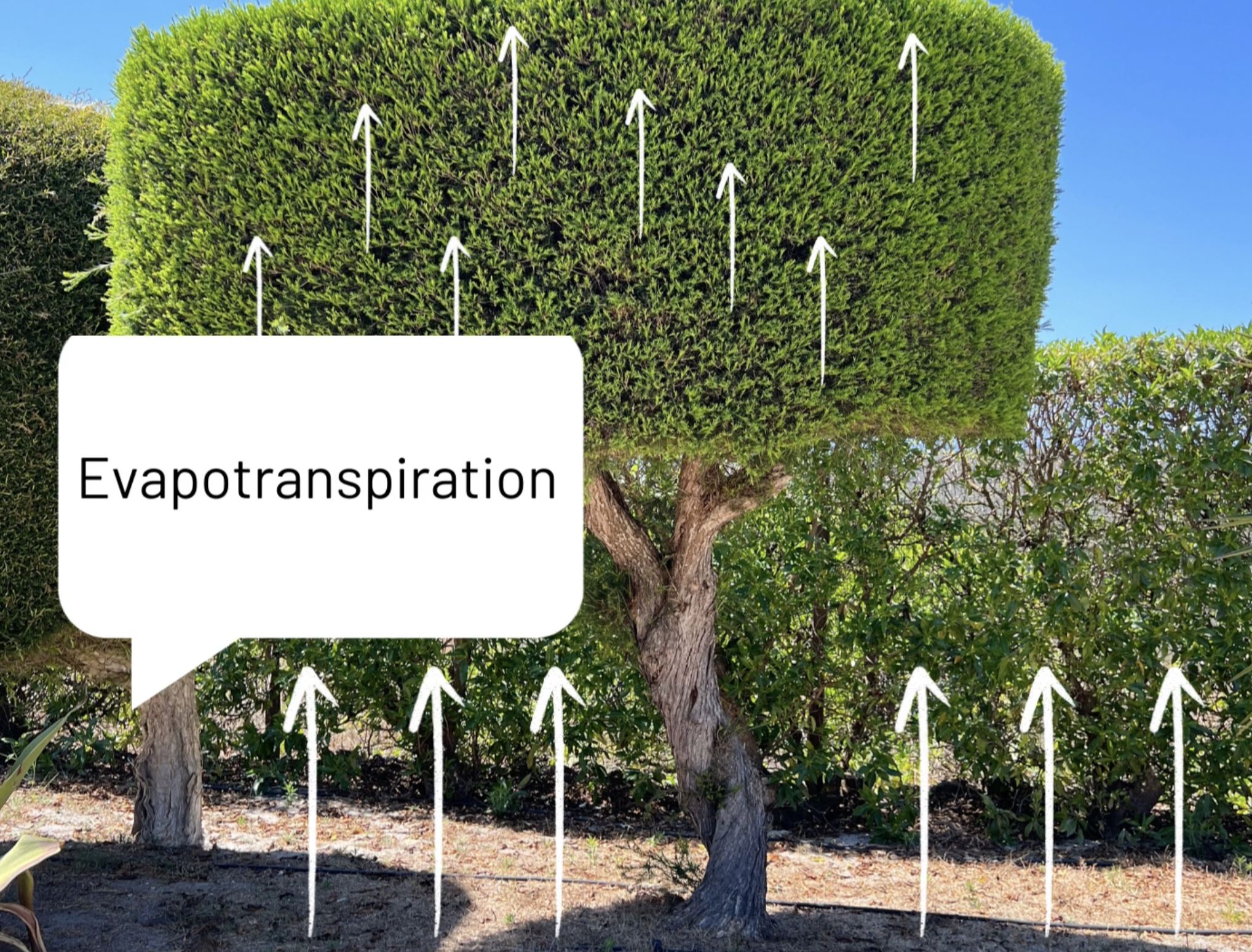
Evaporation is the physical process by which water (or another liquid) passes from a liquid state to a gaseous state. For evaporation to take place, some molecules on the surface of the liquid must receive enough energy to overcome the forces of attraction between them and escape into the air as vapour. This energy is taken from the surrounding environment. So, when the water molecules evaporate, they take this thermal energy with them and as a result, evaporation has a cooling effect. A common example of this is the sensation of coolness we feel when we sweat: the evaporation of sweat from the skin removes heat from the body, helping to keep us cool.
The architecture of some houses includes a fountain in a central courtyard, such as typical houses in the south of Spain or in Morocco, whose purpose is to lower the temperature on hot days.
Evapotranspiration influences the climate because it has a cooling effect on the air, especially on hot days, and increases atmospheric humidity, leading to greater chances of precipitation. Understanding evapotranspiration emphasises the importance of plants in maintaining environmental balance and the need to protect natural vegetation.
Deforestation, i.e. the removal of trees, reduces evapotranspiration, affecting local and global climates and leading to a loss of biodiversity. Urbanisation, industrialisation, logging and the cutting down of trees to create fields for crops and pastures for livestock are the main causes of deforestation worldwide. These actions in turn lead to a decrease in evapotranspiration and an increase in the surrounding air temperature.

How does this video link to sustainability?
Sustainability seeks to protect biodiversity and preserve healthy ecosystems. This project shows that deforestation poses significant threats to biodiversity, leading to habitat loss and in the climate.
Sustainability involves collaboration and shared responsibility and this project shown in the video motivates individuals to work together in supporting global initiatives and protecting vulnerable regions.
When we talk about the importance of decreasing our ecological footprint and develop STEM activities at school, we should think of how to achieve the smallest possible ecological footprint ourselves. This project uses recycled material and in small quantities, so we are teaching by example.
STEM activities allow students to build and use models that help simplify complex natural phenomena such as climate change. By using a model and low-cost materials, we can explain the phenomenon of evapotranspiration in plants and its effects.
Differentiated learning
Explore ideas how you can use this material in your class and adapt it to a group of various levels and learning styles.
- Students can conduct an extension of this experiment and measure the amount of water collected on the leaves of the plants on days with different average temperatures (on a warmer day and on a cooler day).
- Advanced learners can measure the temperature of each thermometer every 5 minutes. This creates a more detailed temperature profile.
- Advanced learners could expand the experiment by measuring temperature changes (in wet and dry cotton pads) in different weather conditions, on warmer or colder days, days with more or less wind, in the sun and in the shade. In this way they can try to conclude what accelerates the evaporation of water.
Career orientation
Which career options are linked to this experiment and how can you introduce them to your students?
By exploring this experimental activity, children not only discover the impacts of climate change, but can also be inspired to consider future careers in environmental protection. This could be a good opportunity to spark interest in professions that seek to understand and find solutions to climate change, such as: environmental Scientist, climate Scientist and landscape architect.
Environmental Scientist
Environmental scientists study how natural elements like trees impact ecosystems and local climates. Environmental scientists are people who study nature and work to keep it safe and healthy. To do this, they first decide what they need to study and plan how to gather information. They often collect samples of things in the environment, like air, soil, and water, so they can study what’s in them. By analysing these samples, they can find out if there are any problems, such as pollution, that might harm plants, animals, or people.
When they find a problem, environmental scientists think of ways to fix it or prevent it from happening again. They also share what they learn with others, like government leaders, companies, and communities, so everyone can help keep the environment safe. To make sure everyone understands their findings, environmental scientists write reports that explain their discoveries and ideas for protecting nature. 3
Environmental scientist video
Environmental scientist, Career Girls
Climate Scientist
Climate scientists study changes in the Earth's climate over time and how they might affect the planet in the future. Climate scientists gather information from the air, oceans, and land to see how they’re changing. Some scientists create computer models that show what could happen to Earth’s climate in the future. Others design special tools to measure things like temperature, sea levels, and ice. Many climate scientists work to find ways to reduce climate change and give advice to leaders on how to protect our environment. Some even teach students or give talks to help everyone understand how to take care of our planet. 4
Landscape architect
Landscape architects design gardens, parks, and public spaces, using trees and vegetation strategically to provide shade, reduce heat, and create more sustainable environments.
Landscape architecture video
Landscape architects video
Landscape architecture, Career Girls
Further ideas
This activity can be developed with the support of other activities that are often part of the primary curriculum. Examples of these activities:
- Investigate how factors such as temperature and wind affect evaporation.
- Investigate whether leaf size affects evapotranspiration.
- Investigate whether temperature affects evapotranspiration.
- Investigate whether light affect evapotranspiration.
A very common activity in primary school classrooms is to see how plants drink water. This activity can be carried out so that the children can see how the water rises from the roots to the leaves. Flowers such as daisies can be placed in a glass of water with a colouring of your choice. Wait a few hours and see if the flower takes the colour of the dye in the water. You can also use celery stalks, which makes it easy to see how the water moves through the stalk by cutting slices off it.
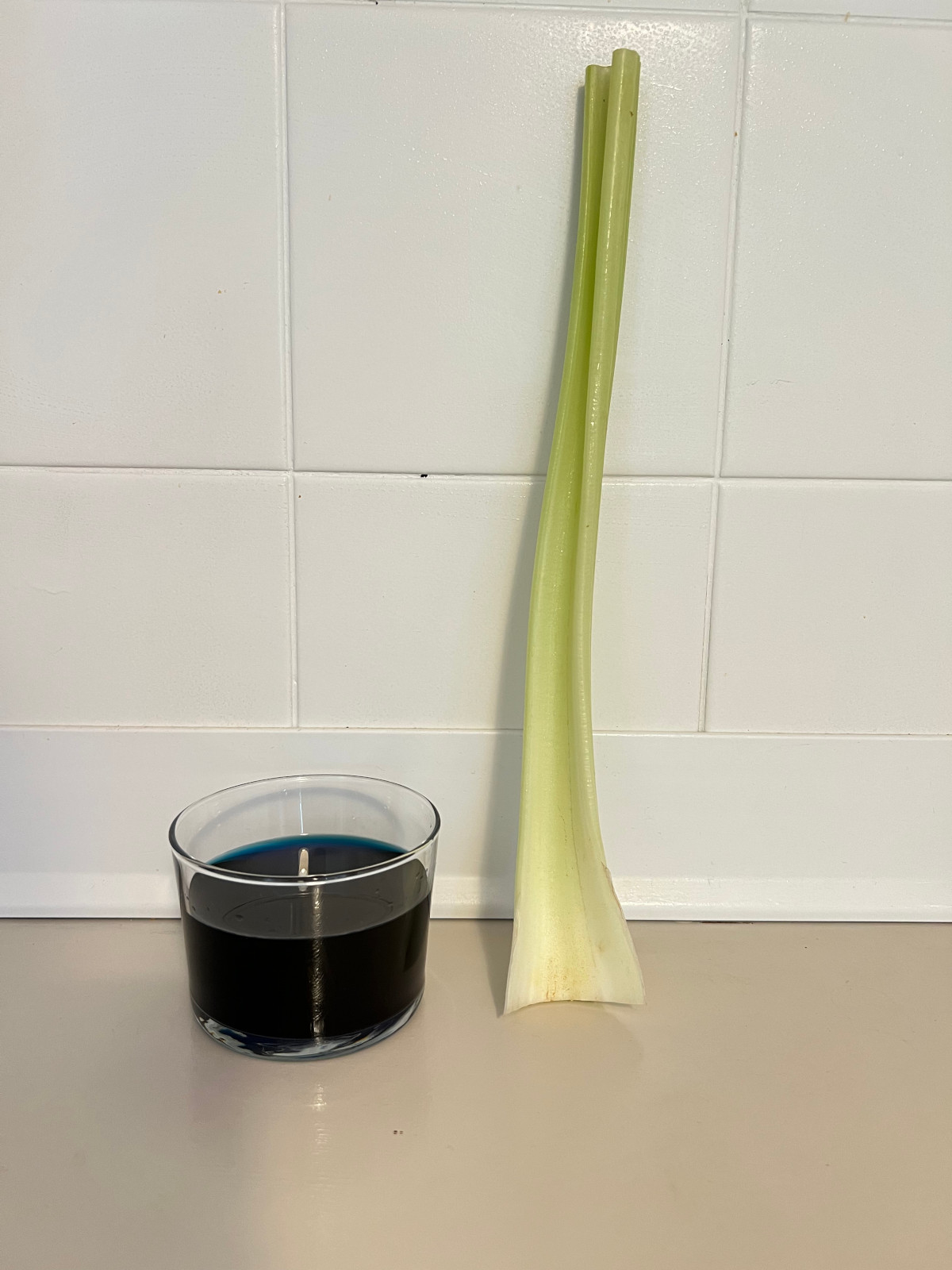

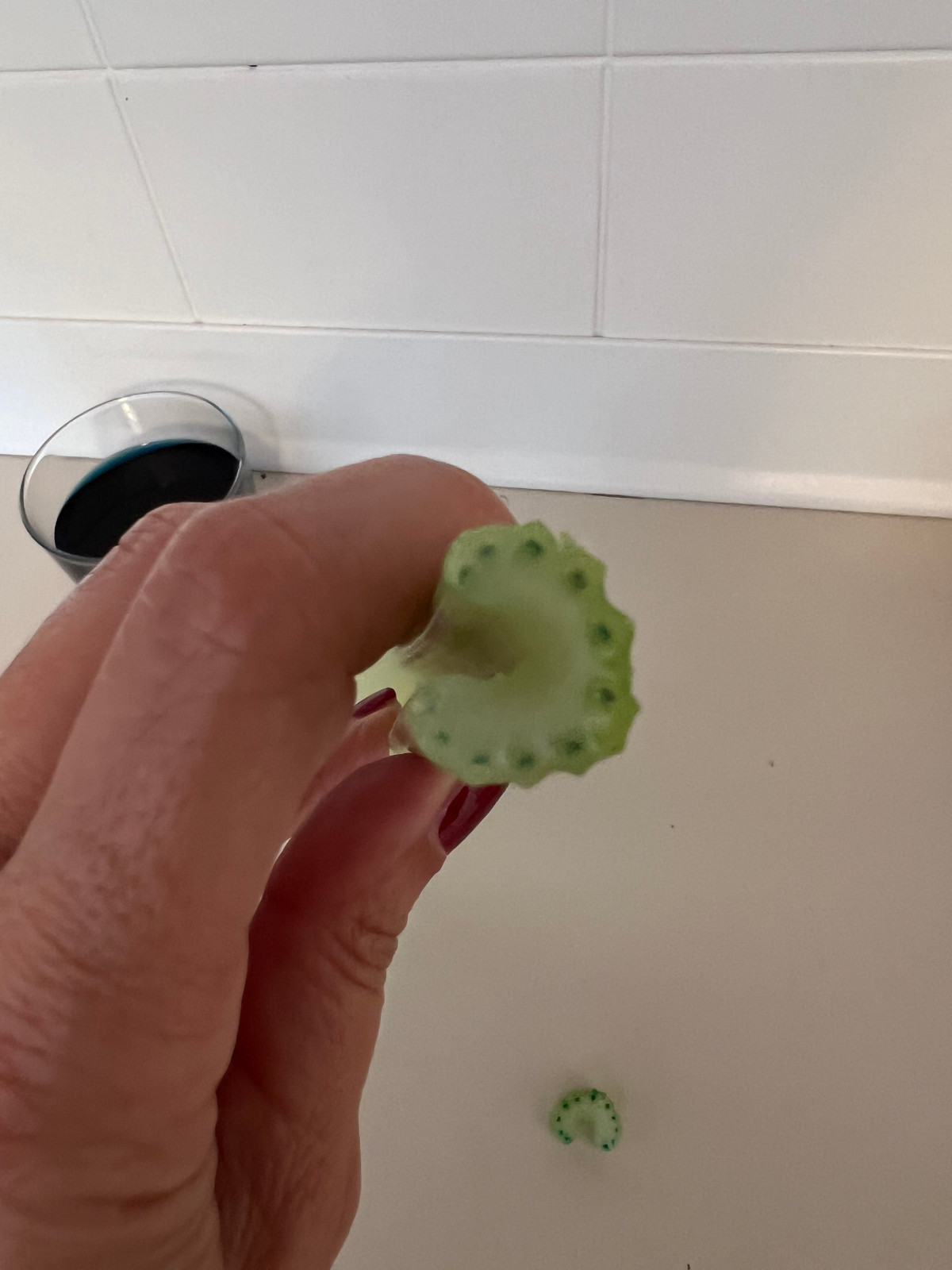
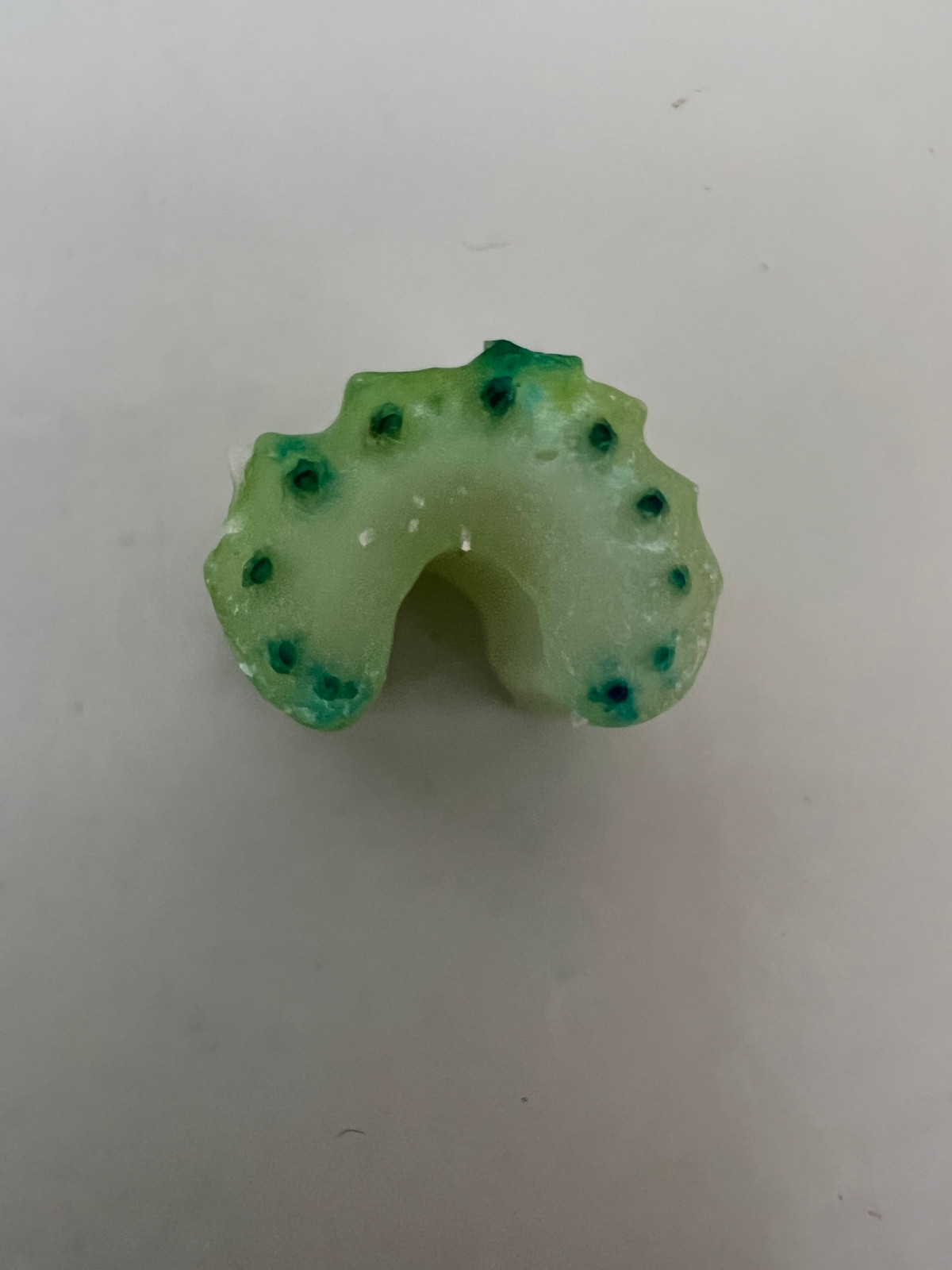
Evaportranspiration, Encyclopædia Britannica
(last accessed 31.10.2024)Evapotranspiration: Watching Over Water Use, NASA
(last accessed 31.10.2024)Career Map: Environmental Scientist, Office of Energy Efficiency & Renewable Energy
(last accessed 31.10.2024)Climate scientist, National Careers Service UK
(last accessed 31.10.2024)Career orientation links:
Environmental scientist (last accessed 31.10.2024)
Environmental scientist, Career Girls (last accessed 01.04.2025)Landscape architecture (last accessed 31.10.2024)
Landscape architects (last accessed 31.10.2024)
Landscape architecture, Career Girls (last accessed 01.04.2025)
This experiment is part of the unit "Flora Focus" written by: Rute Oliveira (PT), Anastasia Papakonstantinou (GR)
Share this page

